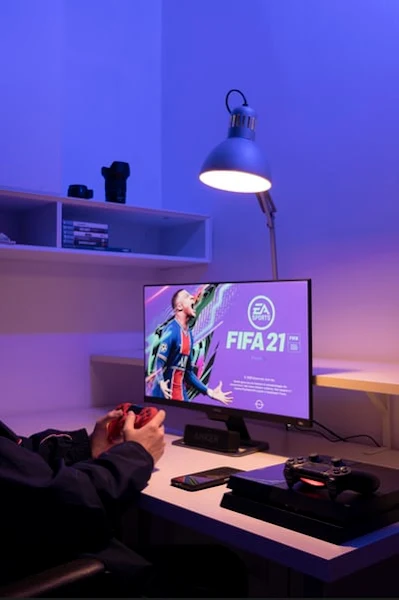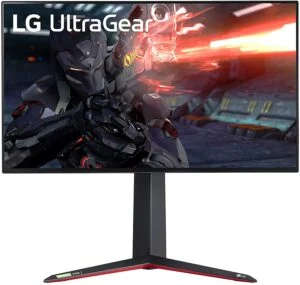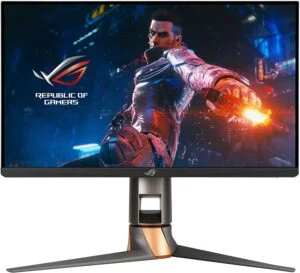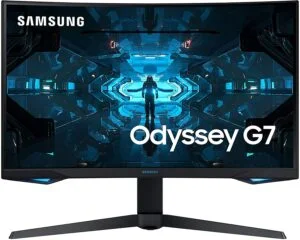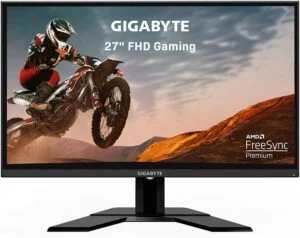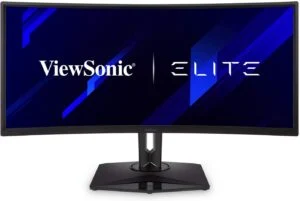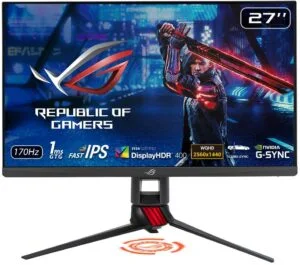In this article, we will talk about What monitors do pro gamers use? - Best gaming monitors. While most gamers are satisfied with the graphics that an average video card gives them, there is a whole lot more to gaming that is not yet possible with technology.
In this article, we will discuss what monitors pro gamers use? and which is the best monitor for pro gamers in the year.
When we are choosing the best gaming monitors?
There are many different types of monitors to choose from, such as IPS, TN, VA, or OLED. Each type of game monitor panel has its own advantages and characteristics, and we also need to consider the screen.
The size and aspect ratio of the camera, but also consider whether it is G-Sync or FreeSync. G-Sync is only available for computers with Nvidia graphics cards, while FreeSync is only available for systems with AMD graphics cards. For the quality of the display image, generally speaking, TN <IPS <VA.
Generally speaking. Generally, TN monitors are the fastest but cheapest monitors due to their weak viewing angles. Compared with VA monitors, the response time of IPS monitors is slightly slower, but the colors are better. The best comparison gaming monitor is VA, but the response time of VA is also slower. Also, consider the refresh rate of the game monitor.
The larger the refresh rate, the better. The refresh rate of the monitor is the number of new information updates per second (expressed in Hertz (Hz)), so it can tell you how many frames per second (fps) the monitor can display.
The higher the number, the smoother the image. Refresh rate is especially important for gamers, so you need to buy a monitor with at least 75 Hz (most gaming monitors provide at least 144 Hz) and also find the shortest response time (response time).
Below we help you pick out the best gaming monitors currently on the market and recommend them for your reference:
Related Topics:
- Best keyboard for gaming: mechanical, membrane, and wireless
- 21 Best Budget Gaming Monitor: Reviews and Buying Guide
- What are the best monitors for gaming: Top gaming monitors
- What is The Best Mechanical Keyboard?
- What is the best gaming mouse in the world?
- What is the most comfortable gaming chair?
- What is The Best Gaming Laptop in The World?
- What is The Best Laptop for College Students
- Best 4K Monitors for Gaming, Home Office, Movies, and Ultra Wide sizes
- What monitors do pro gamers use? - Best gaming monitors
- What Are The Best Useful Accessories To Buy For Macbook Pro?
- Why Do People Choose to Buy Apple Products?
What Monitors Do Pro Gamers Use? - Best Gaming Monitors
1. Best gaming monitor: Dell 32 Inch S3220DGF LED Curved QHD 2K(2560×1440) FreeSync, Monitor
Screen size and aspect ratio: 32 inches, 16: 9 | Resolution: 2560 x 1440 @ 165 Hz | Panel type: VA/W-LED, edge array | Refresh rate: 165 Hz | Response time (GTG): 4ms
Advantages: high contrast and brightness; 165Hz refresh rate; high color accuracy; excellent manufacturing quality
Disadvantages: no sRGB mode
This Dell 32-inch is curved (Dell S3220DGF) gaming monitor can provide stunning panoramic views during gaming. The vibrant 2560 x 1440 resolution and 3000:1 contrast ratio provide precise colors and an immersive gaming experience. The Dell S3220DGF gaming monitor has AMD FreeSync 2, which can reduce screen tears and cracks, and the 165Hz refresh rate makes the game action smoother. It has a 16:9 aspect ratio of 2K QUAD HD 2560 X 1440 resolution, providing crystal clear image quality with stunning details. VESA DISPLAYHDR 400 technology can ensure realistic fidelity and eye-catching colors, so the display of games and movies fully meets the expectations of developers or filmmakers.
And its 4MS response time can help prevent blur, ghosting, and streaks in the intense action of video games and movies. 165HZ refresh rate can provide powerful performance, so you can make full use of games and videos. It is a monitor very suitable for playing games.
2. Best 144HZ Gaming Monitor: Razer Raptor 27 WQHD(2560×1440) Gaming Monitor
Screen size and aspect ratio: 27 inches, 16: 9 | Resolution: 2560 x 1440 @ 144 Hz | Panel type: IPS | Refresh rate: 144 Hz | Response time (GTG): 4ms
Advantages: excellent HDR contrast; brilliant colors; DCI-P3 coverage close to 100%; fantastic style and quality
Disadvantages: no sRGB mode
Raptor 27 is an excellent one-handed gaming monitor from Razer, it has the solid quality and outstanding performance. Although it does not have an sRGB mode, its DCI-P3 color gamut is very wide, and it has both SDR and HDR content, so the colors are very beautiful and gorgeous.
It has almost all the features of a gaming monitor: 144Hz refresh rate, FreeSync and G-Sync compatibility, IPS panel, QHD resolution, HDR and DCI-P3 extended colors, and 4ms response time.
It also comes with all necessary cables: HDMI, DisplayPort, USB-C interface. It has no built-in speakers, but you can use a 3.5mm headphone jack. It can be said that it is a very good 2K gaming monitor.
3. The best 4K gaming monitor: LG 27GN950-B 27 Inch UHD (3840 x 2160) Nano IPS Display Ultragear Gaming Monitor
Screen size and aspect ratio: 27 inches, 16: 9 | Resolution: 4K | Panel type: IPS | Refresh rate: 144 Hz | Response time (GTG): 1ms
Advantages: excellent HDR; very fast response; 144HZ, 1ms response time; wide and accurate color gamut
Disadvantages: high price
The LG 27GN950-B is the best 4K gaming monitor, providing a clear, high-resolution, high-quality gaming experience. This screen has the response speed of the best 4K monitor we have seen, and its response time is consistent with other 144 Hz monitors.
If you have a powerful enough graphics card to support the 4K high frame rate, this monitor can keep up with the speed without any problems. Its 144Hz refresh rate combined with a 1ms response rate can provide smoother and clearer motion while reducing blur and ghosting. It has realistic and true colors, enhanced contrast, sharpness and detail, an ultra-fast 1ms response speed.
Its bracket is also very adjustable, which can be raised, lowered, tilted, and rotated. The bracket is ergonomically designed, which can easily adapt to your environment and game style. LG 27GN950-B has richer game colors, which can be expanded up to 133.9% of sRGB.
Its appearance is also very good-looking, with a 4-sided virtual borderless display. And this LG 27GN950 Monitor4K monitor is a G-SYNC compatible monitor that has been tested and officially verified by NVIDIA, which can reduce screen tearing and minimize stuttering, thereby providing a smoother and faster gaming experience.
At the same time, HDR looks great due to the display's edge array backlight and local dimming function. HDR content has a contrast ratio of 8.45.3:1, which makes it a very good 4K gaming monitor.
4. The best e-sports gaming monitor: ASUS ROG Swift 360Hz PG259QN 24.5 inch HDR Gaming Monitor
Screen size and aspect ratio: 24.5 inches, 16:9 | Resolution: 1920 x 1080 | Panel type: IPS | Refresh rate: 360 Hz | Response time (GTG): 1ms
Advantages: excellent IPS contrast; unparalleled speed and response; with no flicker and low blue light technology, can minimize eye fatigue
Disadvantages: high price
Although the 360Hz speed is faster than most gamers need and the graphics card can handle, if you are an e-sports gamer and want the fastest speed, then you can now use a monitor with a 360Hz refresh rate. Playing games at this refresh rate has a very significant advantage. No matter how fast the movement is, the background and objects are completely unblurred, which is very suitable for professional gamers.
Of course, you can get a high-resolution display, but at this speed, we may not need high-resolution. Its disadvantage is that it is expensive, especially considering it is a 24.5-inch 1080p display.
However, due to the excellent contrast ratio of the IPS panel (1,265:1 according to our test), this is still a multifunctional display that can be used for office and other non-gaming tasks.
5. Best budget gaming monitor: Acer XFA240 bmjdpr 24-inch Gaming G-SYNC Compatible Monitor
Screen size and aspect ratio: 24 inches, 16: 9 | Resolution: 1920 x 1080 | Panel type: TN | Refresh rate: 144 Hz | Response time (GTG): 1ms
Advantages: out-of-the-box color accuracy does not need to be adjusted; smooth and tear-free games can be played; FreeSync and G-Sync compatible; good build quality
Disadvantages: only 1920 x 1080 pixels
At this price, it can be said that it is a very good and excellent gaming monitor. Although its pixels are only 1920 x 1080, it can complete its mission perfectly when playing games at 144 fps. It has a complete set of ergonomic adjustment functions, including rotating 60 degrees to both sides, rotating 5 degrees forward, tilting 35 degrees backward, and a height range of nearly 5 inches.
This Acer XFA240 gaming monitor is based on a TN panel and has a peak brightness of 350 nits, a static contrast ratio of 1,000:1, an 8-bit color depth (6 bits + 2 bits FRC), and a 160°/170° viewing angle.
Although the colors of TN panel displays are not as vivid as IPS and VA panels and do not have high contrast, they do provide the best response speed of only 1 ms. When you add a 144Hz refresh rate to it, you will get an incredibly responsive and engaging fast-paced gaming experience.
6. Best Curved Gaming Monitor: SAMSUNG 27-inch Odyssey G7 – QHD 1000R Curved Gaming Monitor
Screen size and aspect ratio: 32 inches, 16: 9 | Resolution: 2560 x 1440 | Panel type: SVA | Refresh rate: 240 Hz | Response time (GTG): 1ms
Advantages: size and shape are very suitable for gaming or work; WQHD resolution 2560 x 1440 makes your gaming world more lifelike than ever; cutting-edge QLED technology
Disadvantages: High price, narrow perspective
This Samsung Odyssey G7 is a multi-function monitor with excellent gaming performance. It has a fast refresh rate of 240Hz and excellent response time. It supports FreeSync variable refresh rate (VRR) technology, is certified by NVIDIA, and is also compatible with G-SYNC.
Its image quality is very good because of its high contrast, out-of-the-box color accuracy, and excellent color gamut. Sadly, due to its VA panel, its viewing angle is narrow, so when viewed from the side, you will quickly lose image accuracy.
In addition, it is a good-performance display, but its aggressive 1000R curve may not meet everyone's preferences. In addition, it also has additional functions such as picture-in-picture/picture-by-picture mode and RGB lighting.
7. The most affordable 27-inch gaming monitor: Gigabyte G27F 27-inch 144Hz 1080P Gaming Monitor
Screen size and aspect ratio: 27 inches, 16: 9 | Resolution: 1920 x 1080 | Panel type: IPS | Refresh rate: 144 Hz | Response time (GTG): 1ms
Advantages: wide color gamut coverage; good game default accuracy; compatible with FreeSync / G-Sync; good contrast; excellent saturated colors; fast response speed; low price
Disadvantages: no sRGB color gamut option
The Gigabyte ( Gigabyte) G27F game looks like an ordinary office display monitor. The displays are not borderless, but each display is only 10 mm, and you will hardly notice them while playing games. It can be controlled by an OSD joystick, making daily use easier and faster. Responsive gadgets can enter a specific sub-menu with just a few clicks, which is easy to operate.
The back panel includes DisplayPort 1.2 and two HDMI 1.4 slots, a 3.5 mm headphone jack, and three USB 3.0 ports for peripherals. Even if you have two additional devices next to you (such as the new Xbox and PS5 consoles), this is sufficient for most gaming needs.
Gigabyte G27F uses a 27-inch IPS panel with a resolution of 1920 x 1080, a refresh rate of 144Hz, and a response time improved by 1 ms. Like most IPS displays, the backlight is rated at 300 cd/m2, and the contrast ratio is 1000:1.
Many people’s first complaint about the Gigabyte G27F gaming monitor is its low pixel density, which can make the game look blurry or pixelated. However, as long as you keep a proper distance from the screen, this will not happen. It can be cumbersome to read text with it because it can sometimes look too large, but since most GPUs are easy to use at 1080p, games will look great with enough frames.
All in all, this Gigabyte G27F is an excellent budget gaming monitor. Its IPS panel has excellent color coverage, and because its default profile is very suitable for gaming, there is no need to calibrate the screen. We like that its pixel response time is fast enough and comparable to TN monitors, so competitive gamers don’t need to worry about blurry images.
8. The best ultra-widescreen gaming monitor: ViewSonic ELITE XG350R-C 35-inch UltraWide Curved 1440p 100Hz RGB Gaming Monitor
Screen size and aspect ratio: 35 inches, 16: 9 | Resolution: 3440 x 1440 | Panel type: VA | Refresh rate: 100 Hz | Response time (GTG): 3ms
Advantages: excellent contrast and accurate colors; fast response at 100 Hz refresh rate; with built-in speakers
Disadvantages: No extra contrast in HDR mode; text reading experience is not very good
XG350R-C is ViewSonic's latest ultra-wide monitor, specifically for the gaming market. A 35-inch 3440 x 1440 MVA display with a maximum refresh rate of 100 Hz, a curvature of 1800R, and FreeSync. But I think its price is a bit expensive for high-end gaming monitors.
ViewSonic also includes some gaming features, including RGB lighting, which ViewSonic calls "ClearMotion" (backlight strobe), and black stabilization. It combines low input latency and basic support for HDR10 content.
Its base is also very large, although we know that some people like these designs instead of large three-pronged shelves, but this thing does take up a lot of space on the table. The good news is that this adjustable stand does support rotation, tilt, and height adjustment.
The port array is good, with two HDMI 2.0, a DisplayPort input, a basic three-port USB hub, and a 3.5 mm audio output jack. Its resolution is 1440p, which is very suitable for playing games, and the aspect ratio is 21:9, making your gaming experience more immersive.
If you like ultra-wide-angle games, you can consider it. ViewSonic must provide adaptive synchronization with low frame rate compensation. It can run perfectly on AMD and Nvidia GPUs, and of course, there will be no flicker issues.
Its disadvantage is that when the text is read, the font is not particularly clear. Its response time and input lag performance are very good, so it is very suitable for playing games, but I think it is not suitable for work.
9. The most affordable curved gaming monitor: Viotek gnv34dbe 34-inch curved gaming monitor
Screen size and aspect ratio: 34 inches, 21: 9 | Resolution: 3440 x 1440 | Panel type: VA | Refresh rate: 144 Hz | Response time (GTG): 4ms
Advantages: affordable price; fast response speed; good contrast
Disadvantages: a little shaky; no height adjustment
Viotek GNV34DBE is a curved gaming monitor with good performance and an affordable price. Facts have proved that its 1500R curve increases the immersive feeling during the game and helps to fill our peripheral vision. Despite the tight curve, we still found GNV34DBE to work well. The picture is not distorted, and we like to open multiple windows to improve work efficiency.
During our test, it has a refresh rate of 144 Hz and a very fast response time. With the help of AMD FreeSync in the game, it allows us to achieve the high pixel density of the 1440p screen and smooth games without any screen tearing. Its color and contrast are also very good.
GNV34DBE has an edge-lit backlight and can also provide an excellent HDR display. Compared with typical SDR monitors, it has a significant improvement. But its disadvantage is that there is no height adjustment, and sometimes it will shake slightly. But for fast gaming monitors with effective curved surfaces, the affordable price of Viotek GNV34DBE can be said to be a good choice among curved gaming monitors.
10. Best 27" 165Hz 1440P 2K Gaming Monitor: AORUS CV27Q 27" 165Hz 1440P 1500R FreeSync Gaming Monitor
Screen size and aspect ratio: 27 inches, 16: 9 | Resolution: 2560 x 1440 | Panel type: VA | Refresh rate: 165 Hz | Response time (GTG): 1ms
Advantages: good contrast; high color accuracy; excellent speed and responsiveness; HDR FreeSync and G-Sync
Disadvantages: Incorrect sRGB mode; no image controls for HDR
AORUS CV27Q has a 27-inch FHD panel (2560×1440 resolution) with a refresh rate of 165hz, allowing you to enjoy original-size games and movies. It uses a 1500R curved panel, which gives you a more immersive feeling than the traditional curvature. Compared with sRGB, DCI-P3 covers more red and green, they are clearer, so you can see more realistic colors.
Gigabyte’s Aorus CV27Q is the best 1440p gaming monitor in terms of high-speed gaming performance. With its impressive specifications, it shines in our input lag and response time tests when competing with 144 Hz competitors. Of course, better performance can be obtained from the 1080p version of Aorus CV27F, but that will not get a clearer QHD resolution or higher pixel density.
Overall, it has a 2560×1440 curved VA panel, an immersive 1500R curvature, a smooth 165 Hz refresh rate, a cinematic 90% DCI-P3 color accuracy, an ultra-fast 1 millisecond response time, and AORUS exclusive active noise reduction technology. The ergonomic stand design, adjustable rotation, tilt, and height, is a good 27-inch 165Hz 1440P 2K gaming monitor.
11. The best 27-inch 1440P 170hz 1ms IPS panel monitor: ASUS ROG Strix XG279Q 27-inch HDR Gaming Monitor
Screen size and aspect ratio: 27 inches, 16: 9 | Resolution: 2560 X 1440 | Panel type: IPS | Refresh rate: 170 Hz, overclocking, 144 Hz native | Response time (GTG): 1ms
Advantages: large screen and high resolution; excellent response time; compatible with FreeSync and G-SYNC; good peak brightness in HDR
Disadvantages: low contrast
This ASUS XG279Q gaming monitor is designed for gamers, with lights on the bracket and back. It has a unique tripod stand, which is different from most ASUS monitors we have tested. It is well-structured, the frame is very thin, and it has a good ergonomic design.
The three metal feet on the stand feel heavy and can support the monitor well. Compared with the square brackets on other Asus gaming monitors, it takes up more space, but there is still enough room for items to be placed in the front.
ASUS ROG Strix XG279Q has excellent manufacturing quality. The back panel and bracket are made of sturdy plastic, and the feet are made of metal. The stand is firm, can support the monitor well, and there is no obvious swing. The bottom bezel is a bit flexible, but this shouldn't be too much of an issue.
Generally speaking, it is well-made and there are no obvious problems in the structure. Its maximum screen resolution is 2560 x 1440 pixels, the refresh rate is 170 Hz, the response time is 1 ms, and the panel type is IPS. It is a very good 27-inch 1440P 170hz 1ms IPS panel display.
12. The best high refresh rate gaming monitor: ASUS TUF Gaming VG259QM 24.5 inch Monitor
Screen size and aspect ratio: 24.5 inches/16: 9 | Resolution: 1920 x 1080 | Panel type: IPS | Refresh rate: 240 Hz (overclocked to 280 Hz) | Response time (GTG): 1ms
Advantages: high refresh rate; extremely fast response time; outstanding ergonomic design; wide viewing angle
Disadvantages: Low HDR peak brightness; lower contrast
ASUS TUF Gaming VG259QM is an excellent IPS monitor that provides a smooth and responsive gaming experience. It shares many similarities with the larger brother ASUS VG279QM because it also has a 1080p resolution and a 280Hz refresh rate. Due to its impressive peak brightness, it has good visibility in bright environments, but on the contrary, it is not suitable for use in dark rooms due to low contrast.
It has an exceptionally fast response time, black frame insertion, and native FreeSync support, and G-SYNC compatibility. It supports HDR10; however, HDR content does not look better than SDR because it lacks a wide color gamut and local dimming. On the bright side, it has excellent manufacturing quality, wide viewing angles, and excellent ergonomics.
ASUS TUF gaming VG259QM monitor is also an excellent monitor for office use. For some people, the screen may be too small, especially for multitasking. However, it can maintain a higher pixel density, so text and images look sharper. It is bright enough to overcome glare and can handle reflections well.
The OSD of VG259QM will be familiar to users who have used Asus monitors before. It is divided into six sub-menus, located on the front and middle of the game. In the upper right area, you can always see the image mode, active input, HDR status, resolution, and refresh rate.
The game is represented by the TUF logo. Here, you will find the overclocking settings. You must use overclocking to run at 280Hz. It also has five levels of overdrive, namely adaptive sync switching, ELMB sync, GamePlus, GameVisual (seven picture modes), and Shadow Boost. Their performance is exactly the same as increasing the black level to enhance shadow details.
After setting 280 Hz, you can switch between Adaptive-Sync and ELMB at will. All three will run simultaneously. When the ELMB is active, the overload is displayed in gray. However, you can still use adaptive synchronization and 280Hz with overload. However, ELMB cannot be used when HDR is enabled. Our suggestion: Disable HDR. LMB with an adaptive synchronization function is the best way to enjoy the VG259QM gaming monitor.
13. Best 27-inch IPS Gaming Monitor: AORUS FI27Q 27-inch 165Hz 1440P FreeSync IPS Gaming Monitor
Screen size and aspect ratio: 27 inches, 16: 9 | Resolution: 2560 x 1440 | Panel type: IPS | Refresh rate: 165 Hz | Response time (GTG): 1ms
Advantages: high color accuracy, excellent saturation; high-quality game performance; good build quality
Disadvantages: SDR performance is average
If you are looking for the best gaming monitor with a 27-inch IPS panel, the Aorus FI27Q will not disappoint. It has one of the best 27-inch IPS panel gaming monitors on the market.
FI27Q has a refresh rate of 165 Hz and has FreeSync and G-Sync compatibility, so it is even better. In our response time test, it also beat 144 Hz competitors, even 165 Hz competitors, including the Aorus CV27Q and Dell S3220DGF described earlier in this article. Its response speed is very fast.
The IPS panel is known for its excellent color, and the color of FI27Q is almost perfect. Its disadvantage is that the SDR performance is average, using SDR games, its colors are average, but it can provide high color saturation. You won't get the same contrast ratio as VA (contrast ratio is 1,000:1), but the black level is better than any other IPS gaming monitor we have tested.
The display supports HDR content, but it is not the best HDR display. In fact, we hardly noticed the performance of SDR, but FI27Q can finally provide excellent images with high-quality gaming features.
14. Best 240Hz Gaming Monitor: Samsung 27-Inch CRG5 240Hz Curved Gaming Monitor
Screen size and aspect ratio: 27 inches, 16: 9 | Resolution: 1920 x 1080 | Panel type: VA | Refresh rate: 240 Hz | Response time (GTG): 4ms
Advantages: excellent gaming performance; good contrast and color accuracy; 240 Hz 4ms VA panel
Disadvantages: no USB port and built-in speakers
For refresh speed, this display Samsung 27-inch CRG5 is quite good. Usually, this kind of refresh rate of 240 Hz is only seen in 1080p resolution and TN panels, but Samsung’s 27-inch CRG5 uses a VA panel, which has high contrast and saturated colors and is the fastest display we have tested.
In addition, it also provides excellent contrast, G-Sync compatibility, accurate colors, and top-notch gameplay. In terms of game performance, it has all the performance that a high-performance or high-definition display has for competitive or casual gamers.
Samsung omitted things like RGB lighting, speakers, and USB ports, but it has a 3.5mm headphone jack. The height of the screen is suitable for ordinary desktops, and you can tilt it 15 degrees, but there is no other adjustment function.
The curve of its screen is very gentle at 1500R, which is a subtly curved screen with an aspect ratio of 16:9. You won't really notice it during the game, but there is a slight surround effect. There is no visible image distortion, but the curve will not reduce the user experience, nor will it increase the gaming experience.
Although its pixel density is 81 pixels per inch (PPI), which is slightly lower than our preferred pixel density (109ppi), the image is still quite clear. Fine details can be well presented in games, videos, and still images. Thanks to the 240Hz refresh rate, mobile content is very smooth. The frame is nice and thin, with only 8mm around the top and sides. The screen is flush, so it does not appear to be bordered when the power is turned off.
The operating buttons of the display are centrally installed at the bottom of the screen. It has a small blue LED. Pressing it will bring up a shortcut menu, from where you can access the complete on-screen display (OSD) and a series of game and image options. The input panel provides two HDMI 2.0 ports and a DisplayPort 1.2 input, but no USB port.
OSD is Samsung’s familiar gaming dashboard, with a dial-like status indicator on the top that displays black equalizer settings, Overspeed gear, refresh rate, power-saving mode, and low input lag options. You can view the current picture mode under all.
For a specific game type, there are seven presets, one of which enables dynamic contrast. The default mode is "Custom", which is the mode we use for calibration, testing, and gaming. It is quite accurate out of the box, but you must set the HDMI value correctly.
When the PC signal is provided through the DisplayPort interface, the 27-inch CRG5 works out of the box. HDMI is a bit complicated because its black-and-white values are not set correctly by default. The first thing we need to do is to change the HDMI black level from "Low" to "Normal".
This makes the entire signal range from 0-256 instead of the video standard's 16-235. When connecting to a game console, a "low" setting may be required, but for a PC, "normal" is the best choice.
The normal color temperature is close to the 6500K grayscale standard, but some adjustments in the "custom" mode provide us with better grayscale tracking. The gamma light is a little bright until we change the preset from 1 to 3. Then, the full contrast potential of the VA panel is realized.
Please try our recommended settings to optimize your 27-inch CRG5 gaming monitor.
Picture Mode: Custom; Brightness 200 nits: 50; Brightness 120 nits: 21; Brightness 100 nits: 16; Brightness 80 nits: 7; Contrast: 74; Gamma: 2.2
HDMI black level: normal; custom color temperature: red 48, green 49, blue 51
Samsung calls CRG5 a G-Sync-compatible display. This shows that its core adaptive synchronization technology is FreeSync, but it is not mentioned in marketing or packaging. Then, the first thing we tested was its FreeSync function, by connecting it to a PC equipped with AMD Radeon R9 285.
The answer to this question is yes, it does apply to FreeSync, but it needs attention. Although the frame rate of "Tomb Raider" is very high- about 90-100 frames per second (fps)-we see that dark objects have obvious ghosting on light backgrounds.
This is a typical symptom of over-aggressive speeding. Access to the OSD shows the gray overload control. It seems that it is locked to the highest setting. To be fair, Samsung did not promote CRG5 as a FreeSync monitor. In the end, we think it is compatible.
After switching to a G-Sync machine with Nvidia GeForce GTX 1080 Ti FE graphics card, I found no problems. Although the overdrive option in the OSD is still grayed out, there is no ghosting at all. Compared with FreeSync, G-Sync is more smooth and more trouble-free when playing games.
In "Tomb Raider", the frame rate easily reached 200 fps, while " Call of Duty: World War II" reached about 160 fps. The control response is flawless, with no visible motion blur. There is no ULMB (Super Slow Motion Blur) or other types of backlit strobe lights, but it is obviously not necessary. In short, this Samsung 27-inch CRG5 monitor is a VA panel gaming monitor with a very fast refresh rate.
15. Best ultra-widescreen gaming monitor: Acer Predator X35 bmiphzx 1800R Curved 35-inch UltraWide QHD Gaming Monitor
Screen size and aspect ratio: 35 inches, 21: 9 | Resolution: 3440 x 1440 | Panel type: VA | Refresh rate: 180 Hz (200 Hz overclocking) | Response time (GTG): 2ms
Advantages: HDR brightness is 1,000 nits; precise color; jewelry-like quality; 200Hz high refresh rate
Disadvantages: high price
The Predator X35 is not an ordinary widescreen QHD curved gaming monitor. Acer starts with a VA panel, which is different from most IPS-based high-speed ultra-wide screens. Then, it installs a Full Array Local Dimming (FALD) backlight with 512 areas, and you can get a screen with almost unparalleled image quality and gaming performance.
It runs at 180Hz by default and provides 200Hz overclocking. It has G-Sync Ultimate, which means it can run Nvidia's latest chip, supports HDR, and has a backlight brightness of 1000 nits. The refresh rate of G-Sync is as low as 24Hz, so you can use it for smooth games even at low refresh rates.
Like any large ultra-wide monitor, the X35 has a lot of desktop space. With the stand, it is nearly 3 feet wide and 1 foot deep. The shelf is all metal, looks very slender, but very strong. There is not even any trace of tilt or swing.
The complete ergonomic design includes a 5-inch height adjustment, a 45-degree rotation to both sides and a 35-degree tilt. The pivot is a stable structure placed between the base and the column to ensure its stable performance. The build quality is almost perfect, and it can provide the ultimate gaming experience.
FAQ of What best monitors do pro gamers use?
What is a gaming monitor?
Gaming monitors are designed to make the graphics card and CPU output look as good as possible during gaming. They are responsible for displaying the final results of all the image rendering and processing of the computer, but their performance in terms of color, motion, and image clarity varies greatly. Game monitors generally have a higher refresh rate than ordinary monitors, for example, 75HZ, 144HZ, 360HZ, etc, and their response time is generally 1-5ms.
What are the common panel types for gaming monitors?
There are generally four categories of game displays, namely: TN panel, VA panel, IPS panel, and OLED panel.
- Advantages of TN panel: For high-speed games such as first-person shooters or fighting games, the refresh rate and response time are very high.
- Advantages of VA panel: Compared with other panel types, the black level is better and the contrast is higher. Usually 8-bit color depth. The viewing angle is wider than that of a TN panel.
- IPS panel advantages: the widest viewing angle, with excellent image quality. Compared with the TN panel, the black is deeper and the contrast is higher. Most are 6-bit + 2, but there are 8-bit and 8 + 2 panels.
- Advantages of OLED panels: OLED has high contrast and bright colors. Eliminating the backlight also makes it slimmer than LCD.
What aspects should be paid attention to when buying a gaming monitor?
When buying a game monitor, you can pay attention to the following aspects of the monitor: look at its panel type, aspect ratio, curved surface or flat surface, size, whether it has an adaptive synchronization function, look at its refresh rate, response time, and color For the accuracy and color gamut, see whether its bracket can be adjusted, etc.
Know someone who might be interested in this article? Share it with them.


